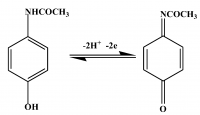Acetaminophen Induced Toxicity
Introduction
Acetaminophen (APAP) is a common analgesic and an active ingredient in many over the counter painkillers such as Tylenol and narcotics such as Oxycodone. Seemingly harmless in normal dosages, large quantities of APAP can result in liver necrosis by depleting glutathione reserves in a dose dependent manner (). APAP misuse is responsible for approximately 50% of acute liver failure cases in the United States (). Treatments for Acetaminophen Induced Liver Injury (AILI) are limited and ineffective if not caught early enough. Considering this and the widespread use of APAP containing pharmaceuticals, it is imperative that the mechanism of acetaminophen induced hepatotoxicity be revisited.
The current accepted mechanism by which AILI presents itself is through a two electron oxidation as illustrated to the left. Under normal condtions, APAP is mostly converted to nontoxic metabollites via sulfation or glucuronidation while a small percentage is oxidized by cytochromes P-450 to the highly reactive metabollite, N-acetyl-p-benzoquinone imine (NAPQI) (). NAPQI is then detoxified through conjugation with glutathione (). During overdose, glucuronides and sulfates are saturated, leading to more NAPQI production, which results in hepatocellular supplies of glutathione becoming depleted as demand for the resource is higher than its regeneration (). The purported two electron oxidation product, NAPQI is then suggested to react with with cellular membranes and proteins, thus wreaking havoc and large scale hepatocyte damage and death ().
However, this conclusion is may not be the best explanation, as NAPQI is reported to be rapidly reduced back into APAP in the prescence of NADPH (2). A single electron oxidation characterized by radical polymerization of APAP is a probable alternative mechanism. The reactivity of the APAP phenoxyl radical could render this molecule responsible for the effects normally attributed to NAPQI (3).
Materials and Methods
Results
References
1. Potter, DW; Miller, DW; Hinson, JA. Identification of acetaminophen polymerization products catalyzed by horseradish peroxidase. Journal of
Biological Chemistry, 260,22 (1985). 12174-2180. Print
2. Dahlin, DC; Miwa, GT; Lu, AYH; Nelson, SD. N-acetyl-p-benzoquinone imine: a cytochrome P-450-mediated oxidation product of acetaminophen. Journal of Biochemistry,
81 (1984). 1327-1331. Print
